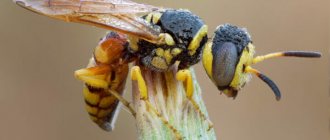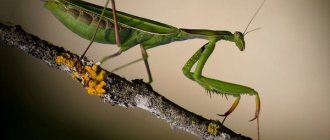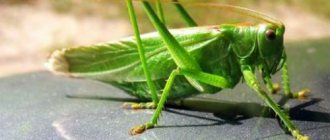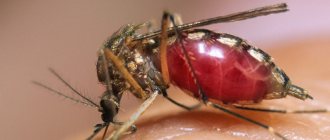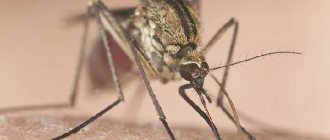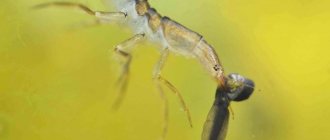Scientists have not yet been able to establish the first appearance of blood-sucking insects, although they have found their remains during excavations. People who encountered these pests noticed the presence of a proboscis, long legs and wings. A mosquito under a microscope has a completely different appearance, which scares and fascinates at the same time. If you use settings with multiple magnification, you can see all the details. And in this case, the person understands that the appearance of the insect is completely different.
Description of the appearance of a bloodsucker under a microscope
What a blood-sucking mosquito looks like under a microscope can be seen in the images presented on the Internet. Looking at photographs taken using photographic equipment and a microscope, you can see that the body is covered with small and dense bristles. This seta is used by blood-sucking insects to navigate and search for certain objects and people. When enlarged, the head is also fascinating, making the mosquito seem like an alien creature. The eyes are similar to a mosaic. They consist of a huge number of fragments connected into one whole.
The mouthparts of a blood-sucking insect have a unique structure. The oral apparatus includes:
- Proboscis.
- Lower as well as upper lips.
- Jaws.
Not only the proboscis of a squeaking mosquito under a microscope, but also its nose resembles tentacles. The insect uses these tentacles to explore the area, as well as search for blood vessels that are concentrated under the skin. If you look at the mouthparts, magnified 160 times, you can see the teeth of a mosquito. The insect has 50 of them in total. The blood-sucking pest is fixed using small teeth.
If you study the structure of the wings under a microscope, you can see small hairs on the outside. On the inside, transverse as well as longitudinal veins are distributed in a certain order. The veins increase the rigidity of the wings. Therefore, mosquitoes easily move through the air and overcome various obstacles.
Protection against midges outdoors
Adjusting your outdoor schedule to the life cycle of a particular midge species is too much and a waste of time. You should turn to more effective insect control options.
Professional approach
There are two types of products that repel midges from the human body: repellents and fumigators. The first ones are applied directly to the skin, the second ones destroy insects within a certain radius.
Repellents (sprays, ointments, lotions)
They are applied to the skin, thereby blocking the olfactory receptors of insects.
- Mosquitall ointment based on diethyltoluamide. Effectively repels midges for 8–9 hours, disorienting the olfactory receptors of insects. Has a pleasant vanilla scent.
- Aerosol Help. Valid for 6–8 hours. Apply to skin and/or clothing. It is dangerous for children under 12 years of age, pregnant and lactating women to use the product.
- Aerosol Gardex based on diethyltuolamide. Lasts 4.5–6 hours.
Aerosol is the most convenient form of repellent
Fumigators
Contains toxic substances that kill midges. Fumigators can be of two types:
- pyrotechnic (the spiral smolders and smokes, releasing substances toxic to midges);
- electric (under the influence of heat, a plate soaked in poison or a bottle with toxic liquid releases these substances into the air and kills midges).
The most popular and effective fumigators are products from the Raid, Mosquitall, and Fumitox brands.
Spiral fumigators are convenient to use outdoors, but their coverage area is not very large
Folk methods of protection
If the use of chemicals contradicts your principles, you can use folk advice.
- Infusion with vegetable oil. Leaves of wormwood, parsley, tobacco, eucalyptus or fir sprigs, vanilla pods, anise seeds, clove buds are infused in oil for 2-3 weeks. After straining the mixture, apply it to exposed areas of the body.
- Ointment based on baby cream or Vaseline. Grind lavender leaves, basil, rosemary, bird cherry blossoms or garlic cloves, lemon zest and mix with the base. Apply as needed.
- Alcohol tincture. In 500 ml of 35% vodka, put 250 g of walnut shells, add 10-15 drops of camphor oil (or 30-40 drops of peppermint oil), leave for 2 days. We lubricate exposed areas of the body, except the face, as alcohol can cause burns.
- Essential oil mixtures. Strong smells repel midges, while many people enjoy this type of aromatherapy.
Table: Effective Essential Oil Blends
| Composition | Ingredients |
| Mint-lavender | 5 drops of lavender oil; 5 drops of mint oil; 20 drops of citronella oil; 0.5 liters of water. |
| Lemon-basil | 5 drops of lemon oil; 20 drops of citronella oil; 10 drops of basil oil; 0.5 liters of water. |
| Vanilla-lavender | 5 drops vanilla oil; 20 drops of citronella oil; 5 drops of lavender oil; 0.5 liters of water. |
Prevention
Since midges, judging by the species table, inhabit the entire globe, with the exception of some northern corners and deserts, it is, to put it mildly, useless to fight the very existence of these insects. All that remains is to choose a means of protection against their bites and listen to the recommendations of experts:
- You should not choose places for walks or picnics near bodies of water overgrown with vegetation;
- at the height of summer there is no need to wear too revealing light clothes;
- You should not stay for a long time in damp shady forests and near swampy lowlands;
- It is better to organize walks and picnics away from livestock farms.
Growing up mosquito
English scientists, using a powerful microscope, were able to examine in detail how the bloodsucker turns from a larva into an adult. To do this, they caught a lot of insect larvae, installed a lamp and began to wait.
The mosquito larva goes through 3 stages of molting and at 4 stages it already turns into an adult. After the last molt, the worm's lips, wings and proboscis open. It rises above the surface of the water and flies away to look for a new source of food.
The enlarged mosquito at the final stage of maturation forms into an adult. Their small worm produces a winged individual, which in a few days will be able to fertilize.
The structure of the oral apparatus under a microscope
In England the insect is often called the flying syringe. A mosquito sting looks like a thin point that pierces the skin. The insect's main weapon has a complex structure, consisting of hollow and non-hollow tubes that control movement, inject saliva into the wound, and suck in blood. A photo of a mosquito under a microscope, its oral apparatus is presented below.
The sting consists of:
- two piercing tubes - maxilla;
- pairs of mandibles - mandibles;
- upper lip - labrum, lower;
- uvula - hypopharynx.
The upper shell of the mosquito's proboscis turns away during the bite, allowing the sting to freely penetrate the victim's skin. Labellas are placed on the lip - they help to choose a suitable place, determine the location of the blood vessel, and are visible under a microscope. After a bite, the labella remain on the surface of the epidermis and do not get inside.
On two piercing tubes - maxillae - mosquito teeth - hard horny scales - are located. There are 50 of them in total. With their help, the insect initially gnaws through the wound, and only then inserts a tube to suck in the blood. Thanks to the sharp teeth, the bite is carried out with lightning speed, the victim does not feel anything. The mandibles hold the skin so that the wound remains open throughout the sucking period. You can trace the process under a microscope.
After such manipulations, it is introduced into the vessel, blood begins to flow into the insect’s body. The mosquito first injects saliva, which prevents the blood from clotting and facilitates the feeding process. The hypopharynx or tongue creates a vacuum in the tube and promotes the flow of blood from the vessel. You can see below how a mosquito bites under a microscope.
On a note!
An enlarged mosquito looks terrifying under a microscope. Its oral apparatus is not just a tube with a sharp end, but a complex system. The mosquito's nose includes the upper, lower jaws, lips, and 7 sharp needles. Each pair performs its own functions. Some of them contain mosquito teeth. These are 50 pieces of keratinized scales with which the bloodsucker gnaws through the epidermis.
Let's look at a mosquito's proboscis under a microscope
Under the proboscis two mandibular palps can be found.
The proboscis is a modified lower lip, which is the most massive element of the oral apparatus.
Inside the trunk is what the mosquito uses to pierce the body of the victim and suck blood from it.
The lower jaw ends in two sensitive lobes - labella.
The lower lip hides the upper and lower jaws. The jaws are elongated piercing organs, sharp at the end, used to prick the skin.
This is a sucking tube formed by a modified upper lip.
When the female pierces the skin, she injects into the wound created a toxic liquid secreted by one of the salivary lobes. This fluid prevents blood from clotting and subsequently causes itching.
The bite is in the details
The pest does not bite immediately. Before this, the pest selects an area on the skin under which a capillary or vein passes. If an insect is very hungry, then it does not spend too much time searching. Scientists examine the meal using a microscope. There are pictures and videos online that can help you understand how a squeaking mosquito bite occurs under a microscope. In laboratory conditions, scientists used a mouse for these purposes, although the scheme for other objects is no different.
The video presented by scientists allows us to understand exactly how the search for a blood vessel under the skin occurs. To do this, the insect uses its proboscis and nose. As soon as a suitable area is found, the pest pierces it with the help of its nose and begins feeding. The duration of the meal is 1–4 minutes. It takes 3 to 5 seconds to find a blood vessel. Since the mosquito sting is flexible, the insect quickly finds the desired area with its help.
The common mosquito: where and how long does it live, what does it feed on in the forest, in the swamp?
This insect can also be found under the name “squeak mosquito”. If we talk about the scale on which these bloodsuckers are found, they are truly surprising.
- Squeakers are found throughout Europe. You can also find them in more remote areas of the Earth; they got there during the time of the Great Geographical Discoveries.
- If we talk about the terrain that peepers prefer, it is most often swamps and forests. Bloodsuckers choose this place for a reason, because they love humidity and warmth. It should also be noted that the common mosquito can live anywhere, provided that its food source, that is, a person, is nearby.
Common mosquito
- Regarding the nutrition of these insects, it must be said that only females drink blood, since it is this type of food that they need for procreation. Males prefer plant juices - this is their only food. The females of this insect, both in the forest and in the swamp, in the absence of humans, look for another source of blood. Often the source is other animals: frogs, birds, etc.
- The life of a mosquito is full of various challenges. Its lifespan depends on the environment and temperature at which the bloodsucker is located. It is important to say right away that females live 1.5-2 times longer than males. Generally speaking, females can live from 40 to 120 days, males are correspondingly 2 times less.
